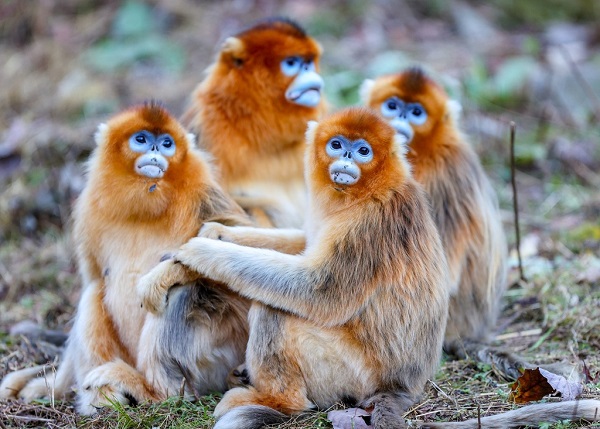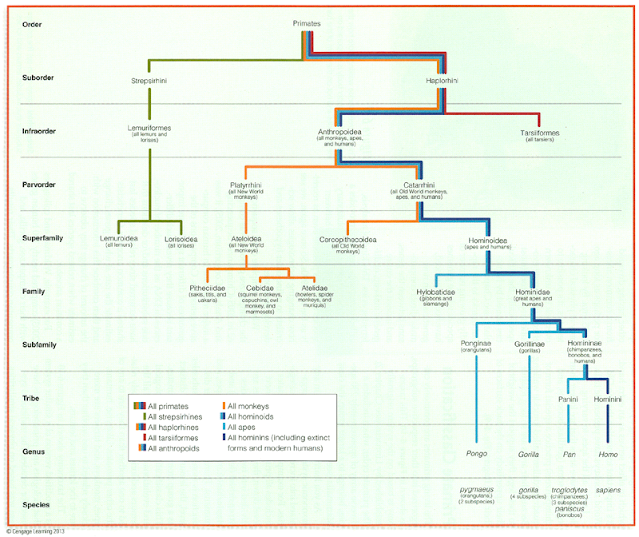Golden Snub-Nosed Monkeys
Olivia Isetts-Williams
ID: The wild golden snub-nosed monkeys in Shaanxi’s Qinling Mountains (China Daily, 2025) Taxonomy
The Snub-Nosed Monkeys, under the grand order of the primates, belong to the primary suborder of Haplorrhini. Moving beyond that, they are identified as the infraorder Simiiformes, which branches into the parvorder Catarrhini—establishing them as old world monkeys—and are further clarified under said identifier with the Cercopithicoidea superfamily. The genus of the Snub-Nosed Monkeys are the Rhinopithecus, as a Greek ode to their unique noses.
These distinctive primates can be characterized by five different species: The Yunnan (Rhinopithecus bieti), Grey (Rhinopithecus brelichi), Tonkin (Rhinopithecus avunculus), Myanmar (Rhinopithecus strykeri), and Golden Snub-Nosed Monkeys, though this blog focuses on the last, also defined as the Rhinopithecus roxellana.
Morphology
The Golden Snub-Nosed monkeys are remarkably unique in their morphology, identifiable by their flat, forward-facing nostrils, stout bodies, blue faces (and scrotums, amongst the males), black amygdaloid eyes, and their thick protruding upper lips (Gron, 2007).
Males tend to differ from the females, with sexual dimorphism lending the former larger bodies, canines, and brighter colouration; particularly observed in their red and brown fur that alternates from the crest (notable for their upright hairs) down their backs and legs. Male Golden Snub-Nosed Monkeys also possess red wart-like swelling on the corners of their mouths (Liang, 2000). These are typically theorized to represent sexual maturity, and assist in distinguishing the two genders.
ID: Height comparison chart between adult Homo sapiens and adult Rhinopithecus roxellana
Rhinopithecus roxellana are the largest of the five species in their genus, with males weighing in at an average of 19.9kg (44lbs) and 58-68cm (1’10”-2’2”) in length, with their more petite female counterparts being an average of 12.4kg (27lbs) and 47-52cm (1’4”-1’7”) long. The females’ heights are comparable to a newborn human baby, who are on average only about 45-56cm in height.As mentioned, the Snub-Nosed monkeys are most notable for their noses, which present themselves as flat inward-facing nostrils accompanied by tiny skin folds. This pug-like nose is a unique adaptation that is thought to protect the monkeys from frostbite in montane environments, which can reach altitudes up to 3300 meters (Kirkland, 1995).
Life History
Golden Snub-Nosed Monkeys may live an average of 23 years, though more information regarding their lifespans tends to be limited outside of captivity due to the scarcity of their populations in the wild. Gestation lasts seven months between the months of April and August, and in turn their breeding seasons last between August and November. Offspring are single birth, and the Interpregnancy Interval (IPI) will typically last between a year or two. This means that weaning occurs at one year of age, which is a signifier of their shorter lifespans, though this weaning period may be prolonged due to the harsh climate conditions they live in. Despite the early weaning period, infants and juveniles may remain within their natal family groups for life.
Females and males reach sexual maturity at different ages. The females may reach this between ages four to five, while males typically reach sexual maturity as old as seven years of age. Golden Snub-Nosed Monkeys are unique in their species in that the dominant males will force their male offspring out of their family units (consisting of a harem up to ten individuals) into other social groups as early as three years of age, while the female offspring typically remain in their family units their whole lives.
The particulars of their development are rather undefinable as a result of the enigmatic nature of these primates, but it can be presumed that subadulthood begins soon after weaning and adulthood follows sexual maturity.
Conservation Status
The Rhinopithecus roxellana are native to the mountains of central and southwestern China, typically along the Tibetan Plateau. They are noted for their seasonally migratory behaviours, which exhibit a trend in moving to higher elevations during the summer and lower elevations during the winter in response to rising and falling temperatures. There are approximately 8,000-15,000 Golden Snub-Nosed Monkeys located amongst protected reserves in China and the wild. While not critically so, they are officially declared by the IUCN Red List of Threatened Species as endangered. This risk that continues to grow is as a result habitat loss, poaching, and disease. Agriculture, logging, and development can be attributed to deforestation for goods and tourism, which seeks to expand its housing and recreational areas into preexisting habitats naturally inhabited by Snub-Nosed Monkeys (Yongchen, 2021). Human development has taken a significant toll on these primates and, as a result, China has enhanced its efforts to protect all five of the Snub-Nosed species through geographic ranges under national government protection (Nüchel, 2018). Currently, research and captive breeding programs are seeking to encourage population preservation and increase to roll back the jeopardy that these singular creatures are faced with.
References
Cerrone, M. (2024, August). Golden snub-nosed monkey, Rhinopithecus Roxellana - new england primate conservancy. New England Primate Conservancy. https://neprimateconservancy.org/golden-snub-nosed-monkey/
China Daily. (2023b, November 9). Golden snub-nosed monkeys in Shaanxi, Sichuan, and Hubei. Your Online Guide to Government Services in China. https://govt.chinadaily.com.cn/s/202311/09/WS655b4e06498ed2d7b7ea07fd/golden-snub-nosed-monkeys-in-shaanxi-sichuan-and-hubei.html
Gron, K. (2007, November 20). Golden snub-nosed monkey. Wisconsin National Primate Research Center. https://primate.wisc.edu/primate-info-net/pin-factsheets/pin-factsheet-golden-snub-nosed-monkey/
Kirkpatrick, C. R. (1995). The natural history and conservation of the snub-nosed monkeys (genus Rhinopithecus). ScienceDirect. https://doi.org/10.1016/0006-3207(94)00039-S
Lewis, R. B., Jurmain, R., & Kilgore, L. (2013). Understanding humans: Introduction to physical anthropology and archaeology. Wadsworth.
Nüchel, J., Bøcher, P. K., Xiao, W., & Zhu, A.-X. (2018, January 23). Snub-nosed monkeys (Rhinopithecus): potential distribution and its implication for conservation. Snub-nosed monkeys (Rhinopithecus): Potential distribution and its implication for conservation. https://rdcu.be/d9GiW
Richardson, M., & Yongcheng, L. (2015, November 22). The IUCN Red List of Threatened Species. IUCN Red List of Threatened Species. https://www.iucnredlist.org/species/19596/196491153





ugh loving the format and info here, giving professional and i'm loving it - love these little alien Kardashian looking monkeys!
ReplyDelete